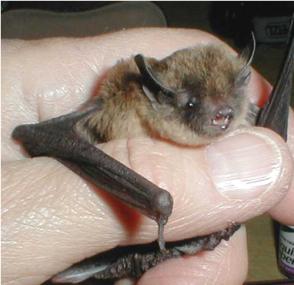Long-legged myotis facts for kids
Quick facts for kids Long-legged myotis |
|
|---|---|
 |
|
| Conservation status | |
| Scientific classification | |
| Genus: |
Myotis
|
| Species: |
volans
|
 |
|
The long-legged myotis (Myotis volans) is a type of bat found in western Canada, Mexico, and the western United States. It's known for its longer legs compared to other bats in its group.
Contents
About the Long-Legged Myotis
The long-legged myotis is a fascinating bat. It belongs to a group called Chiroptera, which means "hand-wing" because their wings are like modified hands! They are part of the Vespertilionidae family, often called "vesper bats." These bats are related to the little brown bat and the fringe-tailed bat. Scientists have found three slightly different types, called subspecies.
This bat is one of the bigger "mouse-eared" bats in the western United States. It has a wingspan of about 10 to 12 inches (25-30 cm). An adult bat weighs around 7.5 grams, which is about the same as a few paperclips! The long-legged myotis gets its name because its lower leg bone, called the tibia, is longer than in other similar bats.
Their fur, called pelage, can be light brown, chocolate brown, or reddish brown. They have short, rounded ears. If you gently push their ears forward, the tips just reach their nostrils. A special feature of these bats is the fur on the underside of their wings. This fur goes from their body all the way to their elbows and knees. They also have a small bump, called a keel, on a part of their leg called the calcar.
Girls and boys long-legged myotis bats look a little different. This is called sexual dimorphism. Female bats tend to be slightly bigger than males.
Where Long-Legged Myotis Live
Range and Habitat
The long-legged myotis lives in a wide area. You can find them from Alaska in the north, all through the western United States, and down into Mexico. They have even been seen as far east as North and South Dakota, Nebraska, and western Texas. Their range stretches south to Mexico City.
These bats can live in many different places. They like ponderosa pine forests, other coniferous forests (like those with pine or fir trees), and pinyon-juniper woodlands. They also live in oak woodlands, mountain meadows, and riparian zones. Riparian zones are areas along rivers or streams. Sometimes, they are even found in desert areas! In mountains, they prefer to live on the middle slopes where there is plenty of food.
What Long-Legged Myotis Eat
Long-legged myotis bats are insectivores, which means they eat insects. Their favorite food is moths. They also eat other insects like flies, lacewings, and some smaller beetles.
These bats leave their daytime resting spots, called roosts, just before the sun sets. They hunt for food most actively during the first four hours after they come out. However, they have been known to hunt all night long!
How Long-Legged Myotis Behave
Roosting Habits
These bats like to rest and sleep under the loose bark of trees. But they can also use cracks in rocks, caves, or even buildings as their roosts. During the summer, they often move to higher places in mountainous areas. When winter comes, they use caves and old mines to hibernate. Hibernation is like a deep sleep that helps them save energy when food is scarce.
Mating and Reproduction
Long-legged myotis bats usually mate in the late summer or early fall. Female bats have a special ability: they can store the male's sperm inside their bodies until spring. This means fertilization, when the egg and sperm join, happens later.
The baby bats, called pups, are born between June and August. Each female bat usually has only one pup at a time. Female bats form large groups called nursery colonies. These colonies can have hundreds of bats! The mothers leave their pups with the colony while they go out to find food. They return to the colony many times during the night to feed their young.
How Long-Legged Myotis' Bodies Work
The long-legged myotis can stay active even when the temperature drops to about 15 °C (59 °F). Since these bats hibernate in winter, they use a state called torpor. Torpor is like a mini-hibernation where their body temperature and heart rate drop to save energy.
A bat's feet are amazing! They are specially designed to let the bats hang upside down without using much energy. Their toes have scaly tendons that lock into place when the bat is hanging. This means they don't have to use their muscles to hold on. They also have special spaces in their heads that help move blood away from their brains when they are hanging upside down. This prevents too much blood from pooling in their heads.
See also
 In Spanish: Myotis volans para niños
In Spanish: Myotis volans para niños


